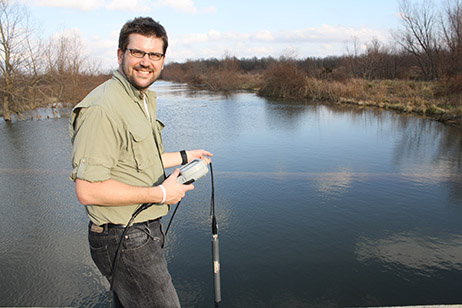
FAYETTEVILLE, Ark. – The Crop, Soil and Environmental Sciences Department in the Dale Bumpers College of Agricultural, Food and Life Sciences at the University of Arkansas is developing a modeling program to measure water quality for the southern region of the United States and is hosting a workshop on water quality modeling.
The public is invited to attend the first day of the workshop, scheduled for Monday, March 23, at the University of Arkansas. The rest of the five-day workshop is reserved specifically for water quality modeling professionals. The workshop will feature a presentation by Clelia Marti, deputy director of the Centre for Water Research at the University of Western Australia.
Anyone interested in attending the first day should contact Thad Scott, associate professor of environmental water science in the UA System Division of Agriculture, for details and location, at jts004@uark.edu or 479-575-6337. Due to limited space, water quality professionals interested in the full week need to register with Scott as soon as possible.
The new modeling effort in the department is part of a programmatic shift to address water quality issues through computer-simulated forecasting. The science of water quality forecasting is advancing rapidly and the new emphasis will compliment ongoing research across several departments on campus focused on watersheds and aquatic ecosystems management.
Water quality modeling involves computer simulations describing the relationship between physical, chemical and biological attributes of lakes and rivers, according to Scott. The goal is to develop models to forecast future water quality conditions.
The workshop training in effect-based modeling will be similar to the platform used by U of A collaborators at the Australian Centre for Water Research. The first project to receive funding focuses on the water quality of Lake Wister in Oklahoma. Funding was provided by the Poteau Valley Improvement Authority,
“Although the U of A has been engaged in watershed modeling for some time, this is the effects-based approach to modeling, which allows us to quantify how water quality improves or deteriorates in response to management,” said Scott.
Scott will use software designed to model water quality in estuaries, lakes and coastal oceans created by the Centre for Water Research. The modeling software, named “Estuarine, Lake and Coastal Ocean Model” and the Computational Aquatic Ecosystems Dynamics Model are known by the acronym ELCOM-CAEDYM. Although the modeling platform has been used extensively in Australia and Europe, it has rarely been used in the U.S.
Models combined with data from recent monitoring activities estimate the nutrient load reductions necessary to achieve state-required water quality standards. The results will lead to watershed and lake management decisions affecting nutrient and sediment loads entering the lake from inflows or outside sources. The overall process is “A Total Maximum Daily Load Estimation” and is used by the Environmental Protection Agency to set and enforce water quality criteria across the country. The models will provide a new tool to complete this process in the southern U.S.
The Lake Wister study marks one of the first applications of the modeling platform in the U.S., but Scott expects it will be more widely used in developing total maximum load estimates, which are required for all waterbodies listed as impaired by the EPA. The project is expected to be completed in the summer of 2016.
Lake Wister is a 6,300-acre shallow lake with uniform temperature and density from top to bottom, meaning lake waters are completely mixed. Impounded, or artificially created, by the Poteau River and Fourche Maline Creek, it was constructed in 1949 for flood control, but also provides drinking water for approximately 50,000 residents of eastern Oklahoma. The lake is listed as impaired due to high levels of the microscopic organism phytoplankton and cloudy water.
A previous modeling study revealed potentially high levels of phosphorus, but other studies showed phosphorus loads to be similar to other waterbodies.
“The Lake Wister ELCOM-CAEDYM model will integrate external and internal nutrient loads better than previous modeling estimates, which will better determine the decisions for a total maximum daily load,” said Scott.
The goals for the Centre for Water Research include:
- Creating tools to quantify sustainability in aquatic ecosystems based on the building blocks of water and carbon
- Optimizing water quality, carbon sequestration, aesthetic value and human satisfaction while delivering maximum water, power, flood control and protein
- Publishing impact papers and produce quality postgraduate students
- Establishing, maintaining and strengthening links with industry by incorporating research results into tools and systems that can easily transfer to industry
Scott hopes to secure funding for future projects from the EPA, U.S. Geological Survey, National Resources Conservation Service, Arkansas Natural Resources Commission and the Arkansas Department of Environmental Quality, as well as other local funding sources.
Contacts
Thad Scott, associate professor, Crop, Soil and Environmental Sciences
Bumpers College of Agricultural, Food and Life Sciences
479-575-6337, jts004@uark.edu
Robby Edwards, director of communications
Bumpers College
479-575-4625,
robbye@uark.edu